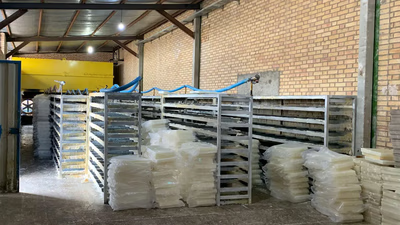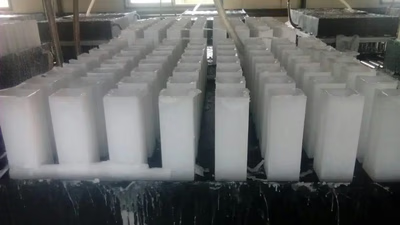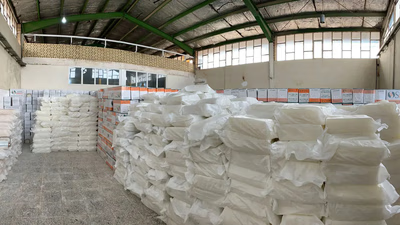
Paraffin wax used in candles and packaging solutions.
Paraffin refers to a group of waxy, solid hydrocarbons that are derived from petroleum or other fossil fuels. It is a white or colorless substance that is odorless and tasteless. Paraffin is composed mainly of long-chain alkanes, which are saturated hydrocarbons. Paraffin wax is the most commonly known form of paraffin. It is produced by refining crude oil, where the waxy substance is separated and purified. Paraffin wax has a low melting point, typically between 45°C and 68°C (113°F and 154°F), which makes it suitable for various applications.
Paraffin wax is widely used in candle production due to its low melting point and ability to hold fragrance and color. Paraffin is found in various skincare products, such as moisturizers, lip balms, and hair care products, as it helps to provide moisture and create a protective barrier on the skin. In the food industry, paraffin wax can be used as a coating for fruits and vegetables to extend their shelf life and enhance their appearance. It is also used for chocolate and candy coating. Paraffin wax is utilized in packaging materials, such as waxed paper and cardboard, to provide moisture resistance and improve the integrity of the packaging.
Paraffin is sometimes used as an ingredient in certain ointments and creams, providing a lubricating and protective effect on the skin. Paraffin finds application in various industrial processes, such as lubricants, electrical insulation, and as a component in manufacturing certain plastics and rubber products. It's worth noting that paraffin is also used in other contexts, such as paraffin oil (also known as kerosene or lamp oil) used for lighting and heating, and paraffin fuel for certain types of engines and heaters.
Paraffin is a colorless, odorless, tasteless compound and a hydrocarbon compound derived from petroleum products. Contrary to popular belief, which limits the use of paraffin to the candle industry, this useful compound has many applications in various industries. In general, paraffin is divided into two categories: solid paraffin and liquid paraffin. Solid paraffin is often used in the candle, and liquid paraffin is for industrial use. In other classifications, paraffins are divided into three categories in terms of application: food, industrial and health. Oral paraffin is mainly used in livestock to solve digestive problems for livestock and in some cases is used in some human foods.
Paraffin is extracted in the petrochemical industry from oil or coal. A saturated hydrocarbon compound in which all the carbon atoms in a molecule are bonded together by simple bonds, and paraffins or paraffinic hydrocarbons are also called alkanes. In other words, these materials are characterized by the bonding of carbon atoms by simple bonds; other bonds are also saturated with hydrogen atoms. Solid and liquid paraffins play an important and undeniable role in various industries such as textile, rubber, insulation, adhesive, cosmetics and packaging, candle making as well as lubricants. It is worth mentioning that the use of paraffin in each animal of the mentioned industries is different, for example, in rubber production, paraffin is used to prevent rubber cracking and in insulation to insulate against moisture and dust.
-

Paraffin wax is a versatile material with numerous applications across various industries. In candle making, it is favored for its clean burning properties and ability to retain scents. Additionally, it serves as a food-grade coating that enhances the appearance and shelf life of fruits and candies. In cosmetics, paraffin wax is used in products like lip balms and lotions to provide moisture and improve texture. Its utility extends to art projects, where it is employed in encaustic painting and mold-making. Paraffin wax also plays a crucial role in investment casting, providing precise patterns for metal castings. Furthermore, microcrystalline wax, a variant of paraffin, is utilized in adhesives and sealants due to its flexibility. The therapeutic benefits of paraffin wax are evident in spa treatments where it aids in heat therapy and skin moisturization.
Other industrial uses include serving as a lubricant, anti-mold agent, and waterproofing agent for fabrics. Its role in packaging materials enhances moisture resistance and sealing capabilities. Overall, paraffin wax"s diverse applications make it an essential component across multiple sectors. "
-

Paraffin is a group of waxy hydrocarbons derived from petroleum, primarily composed of long-chain alkanes. It exists in solid and liquid forms, with paraffin wax being the most recognized variant. Paraffin wax has a low melting point, making it ideal for applications such as candle production, skincare products, and food coatings. In the food industry, it enhances the appearance and shelf life of fruits and vegetables. Additionally, paraffin is used in packaging materials to improve moisture resistance. Beyond consumer products, paraffin plays a significant role in industrial processes including lubricants, electrical insulation, and manufacturing plastics and rubber products. It is also utilized in livestock feed to address digestive issues. The petrochemical industry extracts paraffin from oil or coal, classifying it into solid and liquid types based on application areas: food, industrial, and health. Its versatility extends across various sectors such as textiles, adhesives, cosmetics, and more.
-

The Middle East, rich in crude oil reserves, is a leading producer of paraffin wax, primarily derived from petroleum refining. Countries like Saudi Arabia, Iran, Iraq, Kuwait, and the UAE have established advanced refining infrastructures that enable efficient production of paraffin wax as a byproduct. The region"s vast resources ensure a steady supply of raw materials and allow for significant export capacities to meet global demand. The quality of paraffin wax varies based on refining techniques and feedstock composition, catering to diverse market needs. The competitive pricing and strategic geographical location of the Middle East facilitate easy transportation to international markets. This integration within the petroleum value chain enhances production efficiency and maximizes value from crude oil byproducts. As a result, the paraffin industry contributes significantly to foreign exchange earnings in the region while shaping global market dynamics through its substantial export volumes. "
-

Paraffin wax is available in various types, each tailored for specific applications across industries. Fully refined paraffin wax is the purest form, known for its high melting point and clarity, making it ideal for food coatings, cosmetics, and pharmaceuticals. Semi-refined paraffin wax retains some impurities and is used in products like crayons and rubber compounds. Microcrystalline wax offers flexibility and adhesion, suitable for adhesives and industrial coatings. Pattern wax is designed for investment casting, providing low melting points and dimensional stability for intricate designs. Container wax is formulated for container candles, ensuring good scent throw and burn performance. The market"s demand drives manufacturers to innovate and develop specialized formulations to meet diverse customer needs. Ongoing research enhances the properties of paraffin waxes, addressing challenges in niche applications while maintaining quality standards. "
-

Quality paraffin is determined by its intended use, with different industries requiring specific characteristics. For instance, in candle making, a lower oil percentage indicates higher quality, while lubrication applications may require the opposite. High-quality paraffin should be white, pure, and free from contaminants like oil and sulfur. It must have a consistent melting point for even performance and a clean appearance without discoloration or foreign particles. Odorless and smooth-textured paraffin is preferred, as strong odors may signal impurities. Reputable suppliers often ensure quality through testing and customer feedback is crucial for assessing product reliability. Transparency and stability over time are also key indicators of good paraffin wax. It should burn cleanly with minimal residue and maintain consistent performance across batches.
Compatibility with other materials is essential for specific applications, particularly in candle making or cosmetics. Safety standards must be met when using paraffin in direct contact with skin or food. Ultimately, choosing a reliable supplier who balances quality with cost is vital for obtaining high-quality paraffin wax.
-

Paraffin oil, discovered in the 19th century by Karl von Richen Bach, revolutionized the candle industry due to its cleaner and safer properties compared to traditional oils. The commercial production of paraffin wax began with Scottish chemist James Young, who developed extraction methods from crude oil. As demand for lighting increased during the industrial revolution, paraffin wax became a popular alternative to tallow candles and whale oil lamps. Advancements in refining processes, such as vacuum distillation and hydrocracking, improved the quality of paraffin wax. Today, it is primarily produced as a byproduct of petroleum refining through distillation and purification techniques. The applications of paraffin wax have expanded beyond lighting to include food preservation, molding, and casting. However, environmental concerns regarding petroleum-based products have led to interest in alternative wax sources like soy and palm waxes. The industry has also diversified with synthetic waxes that cater to specific needs across various sectors.






